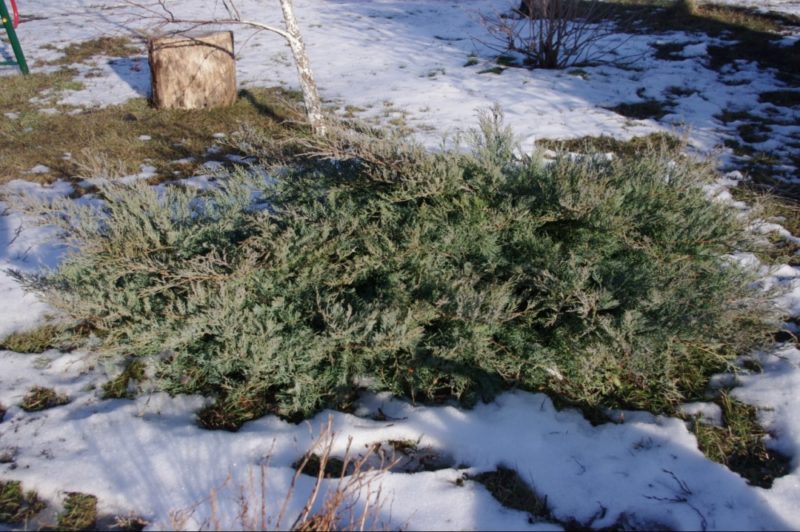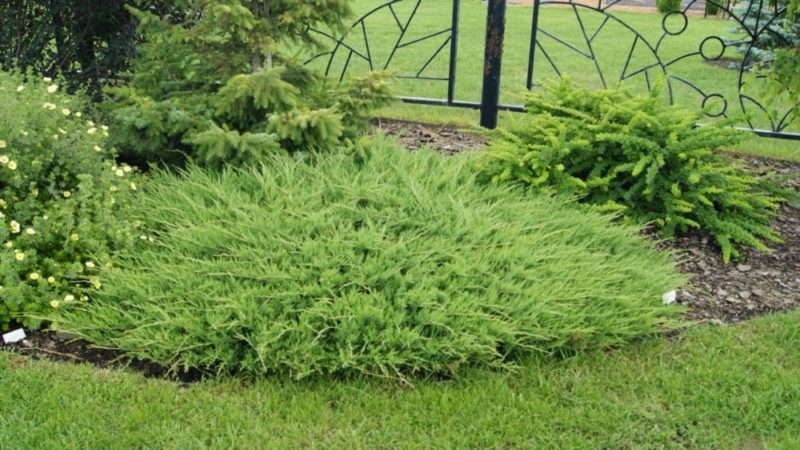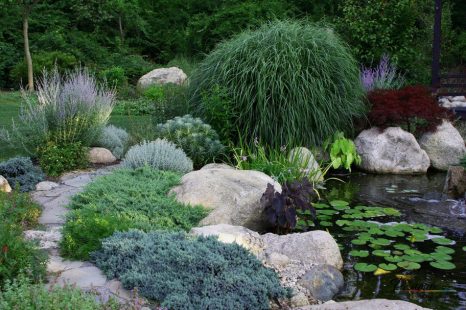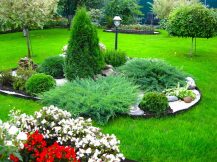Creeping juniper belongs to the vast Cypress family, which is already thousands of years old.
Material Content:
Description of the type of shrub
Junipers of creeping species are very reminiscent of fluffy carpets. These plants lend themselves well to forming pruning. They can be called unpretentious, hardy and not difficult to care for.
- An adult shrub does not exceed a meter in height, while in breadth it can grow to more than two meters.
- The color of the needles, depending on the species, can be either silver-blue or saturated dark green. Blue junipers look especially decorative.
- Fruits are cone berries.
Creeping, or horizontal, juniper is divided into varieties. Some of them may be only 10-15 cm high. There are also undersized species reaching 50 cm. Higher species of creeping juniper are also grown.
Varieties of juniper creeping
Varieties of juniper creeping amaze with their beauty. The most popular varieties are Douglas and Cirrus.
- Douglas is the lowest. The plant looks like a carpet, the needles have scales and a blue color.
- The "cirrus" juniper is slightly higher, and its needles are longer. It is worth saying that in winter both varieties become brownish, and in the spring they again acquire a rich shade of needles.
- The Admirabilis cultivar, which has a flat shape, is growing rapidly. Plant height is only 30 cm, shoots are bluish.
Outdoor planting and care
Juniper horizontal planted on a sunny platform. The optimal landing time is September - October or May.With all responsibility, it is worth treating the planting process, since it depends on how well the plant takes root.
Planting a bush step by step:
- Dig the selected area onto the bayonet.
- Dig a hole three times the seedling rhizome.
- At the bottom of the hole, drain at least 10 cm thick.
- Half fill the pit with nutrient soil and spill.
- Place the seedling so that the neck is at the same level in the soil as it was in the container.
- To fill in a bush, to compact, fill in with water and to mulch.
Caring for this crop is easy.
The most important stage is watering. Although the plant tolerates short-term drought not bad, in dry periods it must be watered, otherwise the needles will quickly lose their decorative effect. Shrubs should be sprinkled periodically.
Water for irrigation is taken only standing up, especially if the plant is still very young.
- After watering, the next day, the earth around the conifer is loosened and necessarily mulched. A layer of mulch will prevent rapid evaporation and facilitate care.
- In spring, it is advisable to feed the junipers with a nitrophos, spending approximately 40 g of fertilizer per square. You can also fertilize with special mixtures for conifers. Apply such compounds strictly according to the instructions, otherwise you can burn the roots. If the seedling grows very slowly and does not take root well, you need to add a little nitrogen, and after a week of potassium.
- In spring, you need to cut the conifers. First of all, broken shoots that are diseased or frozen are removed. When forming the crown, the branches are pruned, giving the desired shape to the bush. You can not radically cut the plant, as this can lead to its death. Young specimens up to three years old are not cut at all.
If you managed to grow sleep on your site strong juniper, its reproduction will not present any difficulty. During the growing season, you can breed shrub layers. Junipers are also propagated by cuttings and seeds, but the seed method is used mainly by breeders.
The main method of propagation of junipers is cuttings. This requires:
- Cut the branches about 10 cm long and keep them in the water for several days, having previously torn off the needles on the lower part.
- Then, cuttings are rooted in the greenhouse.
- After about one and a half to two months, the young plants will give root.
- It will be possible to land them in the open ground only after a couple of years.
How to care in winter
Plants should be tied up when cold weather sets in. They do this so that the branches do not break under the weight of the snow.
The circumstellar circles of young shrubs are mulched with a thick layer of fallen leaves. If the region has cold winters, it is necessary to cover young junipers with spruce branches to protect them from freezing.
These plants tolerate wintering well.
Protection against diseases and pests
To combat the diseases of junipers and their pests, special products are sold in gardening stores. Due to dampness, plants can get sick with Fusarium infection, as well as ordinary shute. Diseases must be treated by spraying conifers with fungicides or Bordeaux fluid.
Of the parasitic insects, junipers are most often bothered by aphids, scale insects and spider mites. You need to deal with pests by treating plants with insecticides or a solution of laundry soap.
Landscaping Ideas
It is impossible to imagine the landscape design of a personal plot without these evergreen, very decorative shrubs.
- Of the junipers are very beautiful plant compositions in which they play a major role. So, the Carpet variety looks great in the middle of the lawn and serves as an excellent background for flowering plants.
- Creeping varieties are also planted in compositions in the foreground, and tall bushes and large trees are grown behind.
- Juniper Cossack is often used in landscaping the garden, as an unpretentious and beautiful plant.It is planted in rock gardens, in solitary landings.
- Annual flowering plants look great against the background of junipers - juicy needles serve as a wonderful background for bright flowers.
In the natural environment, juniper can live for more than a century. Home conditions shorten the life of these conifers, but nevertheless a luxurious shrub can decorate the garden for about 30 years.



















